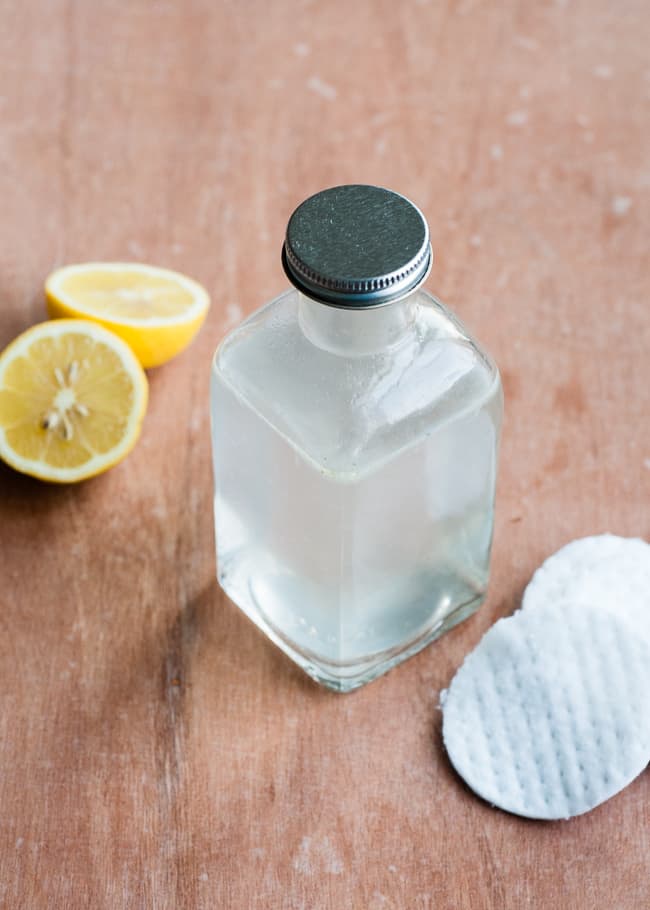Toner might not seem like the most important product in your skincare routine, but most dermatologists agree that it doesn’t get the credit it deserves, especially for those dealing with oily or acneic skin.
Meet the experts
Dr. Papri Sarkar, a Boston-based board-certified dermatologist
Dr. Marisa Garshick, a board-certified dermatologist at Medical Dermatology & Cosmetic Surgery (MDCS) in New York
Medically reviewed by Dr. Jennifer Haley, a board-certified dermatologist on Hello Glow’s panel of medical reviewers
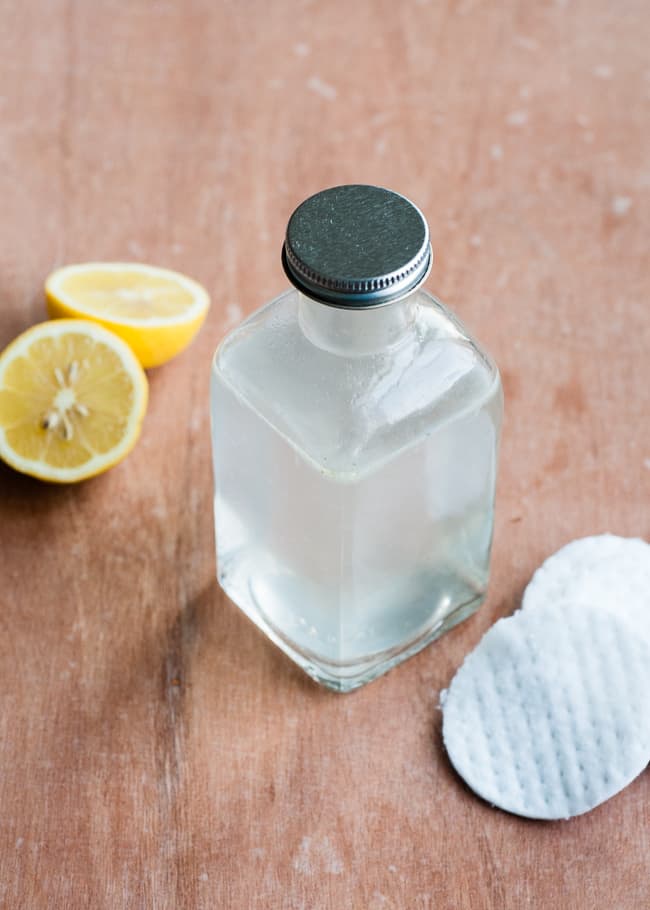 Back in the day, there was an assumption that toners were potentially irritating for the skin—and for good reason. They were full of astringent and alcohol, which made them dry out the skin.
Back in the day, there was an assumption that toners were potentially irritating for the skin—and for good reason. They were full of astringent and alcohol, which made them dry out the skin.
The new generation of toners is more sophisticated, according to Papri Sarkar, M.D., a Boston-based dermatologist. “These days, toners are a way to introduce different ingredients into your routine with a light formulation,” she says. “For example, if your skin needs a light, gentle exfoliation, but you don’t want it to dry out at all, using a toner with polyhydroxy acids can help.”
What does a face toner do?
If you have oily or acne-prone skin, you’re probably using a cleanser that’s a little on the acidic side of the pH scale, which is more antibacterial. But if you have dry or sensitive skin, you most likely are using a cleanser on the alkaline or softening side. A toner helps equalize the skin’s pH after cleansing, bringing it back to its optimal level.
We want our skin to be at its natural pH as much of the time as possible. The skin’s pH should typically be around a slightly acidic 5.5, which supports the acid mantle, a protective layer on the surface of our skin. When its pH is in the ideal range, the skin can function best to protect and renew itself.
But it’s not all about pH balance.
Face toner also helps:
Remove leftover dirt, makeup, and oil. Like a second cleanser, toner helps remove the remains of makeup and grime that you may have missed the first go-around in your skincare regimen.
Hydrate skin. Spritzing toner directly on skin helps replenish moisture. Use it before applying your moisturizer to help seal in the ingredients.
Make skin appear smoother. Toner can also be applied with an exfoliating cotton round to remove any build-up of dead skin cells.
Infuse the skin with extra vitamins and botanicals. Adding herbs, green tea, and essential oils provides skin with a boost of antioxidants, vitamins, and minerals.
Encourage your other skincare products to sink in. After using a pH-balancing toner, your skin will be best prepared to absorb the effective ingredients in your skincare regimen.
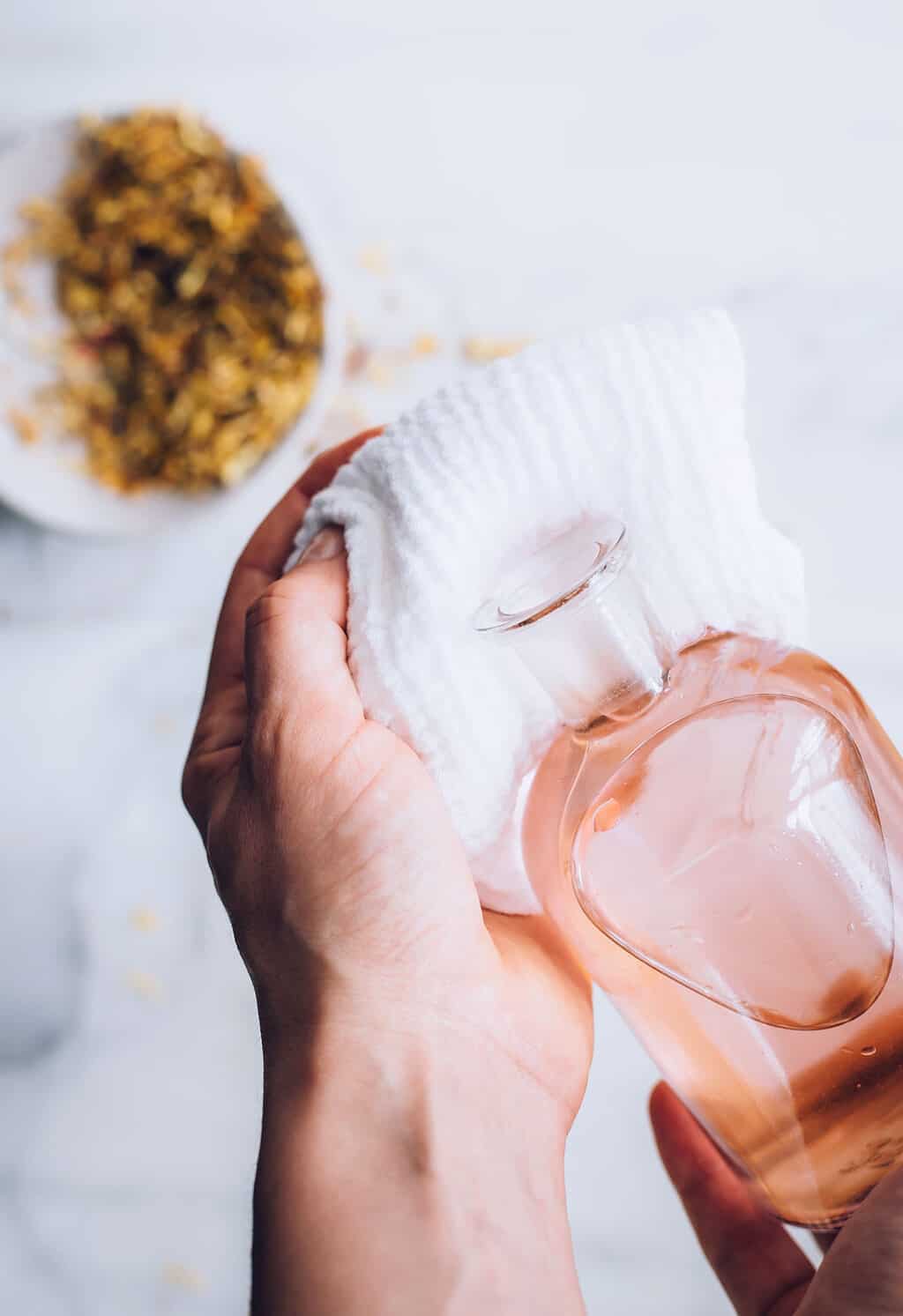
Does everyone need to use toner?
No, it really depends on your skin type, as well as what skin problems you’re looking to minimize, according to Dr. Sarkar. “If you’re looking to increase hydration without clogging pores, using a toner that’s alcohol-free but has hydrating or humectant ingredients like glycerin or hyaluronic acid is helpful,” she says. If your skin is naturally smooth and radiant, you can get away with using fewer products on your skin, including toner.
But if you have oily or acne-prone skin, toner can help balance it out, so it appears less oily. Or, if your skin is lacking certain vitamins and minerals, it wouldn’t hurt to give it a botanical boost or lock in extra moisture.
What to Know Before Using Toner
If you are someone who is prone to dryness, Marisa Garshick, M.D., a dermatologist at Medical Dermatology & Cosmetic Surgery (MDCS) in New York, recommends using an alcohol-free toner to minimize any potential irritation of the skin. She also recommends being cognizant of the other products you’re using, especially those that exfoliate. “Using too many exfoliating products in the same routine can lead to irritation and potential infection,” she warns.
How to Use Toner
Toner is best applied to fresh skin once or twice daily. As always, stop using it if you notice any redness or irritation.
1. First, wash your face and gently pat your skin dry.
2. Shake your toner, and spritz it on your face, neck, and chest. Alternatively, you can pour a bit of toner on a cotton ball or in the palm of your hands and apply it that way.
3. Allow toner to sink in for about a minute before applying serum or moisturizer. Applying serum or moisturizer while your skin is still slightly damp will help to lock in moisture and keep skin supple.
4. Apply sunscreen to prevent any potential photosensitivity (sunburn) issues.
5. Reapply in the evening.
6. While toner works best on clean skin, you can apply it throughout the day by spritzing as a face mist to refresh the skin or revive your makeup. The nutrients won’t sink in as easily, but it will make your face appear fresher and less dry.
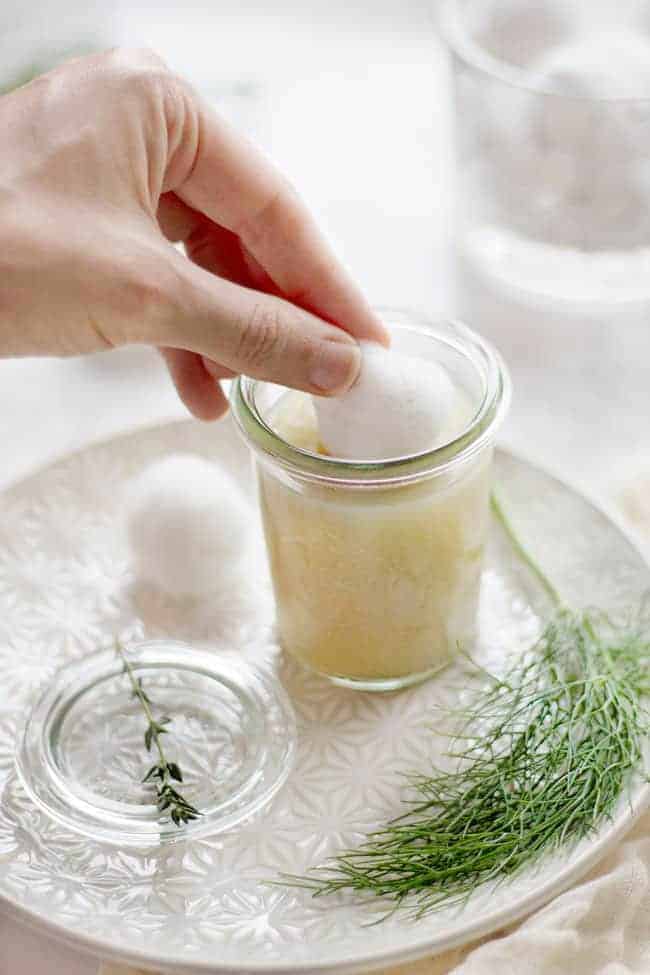
Face Toner FAQs
When should I apply face toner?
I recommend applying your DIY toner twice a day, just after cleansing your skin but before applying your other skincare products.
Spritz it on directly or apply a light layer using a cotton ball, then allow it to sink in for about a minute. Before it’s had a chance to completely dry, apply your serum and then moisturizer to lock in the nutrients.
Can I use face toner on my body?
Absolutely! Using toner on your body will have a similar effect as it will on your face. The only issue that Dr. Sarkar points out is that products made for the face tend to be pricier than those made for the body. “I regularly tell people a toner formulated for clogged pores or acne on the face can be used on their chest or back—and if a toner (or other skincare product) seems like it’s too reactive for my face, I will often use it on the body instead,” she says.
Is toner supposed to burn?
Honestly, it depends on the ingredients. Apple cider vinegar has been known to sting, especially if you have sensitive skin. Other ingredients can cause a mild burning or stinging sensation when initially applied, but Dr. Garshick notes that burning or stinging is often a sign that your skin may be sensitive or too stripped.
“While some products can take some getting used to, if it continues to persist, it is best to skip a few days,” she explains. “In this case, it is often best to wait on the toner while applying gentle products to help strengthen and support the skin barrier, and then it can be okay to try again.”
Can I add a preservative to make my toner last longer?
You can, if you like, although I haven’t tried it myself. If you choose to experiment with a preservative, I recommend using a natural one like grapefruit seed extract to keep your product as clean as possible.
You can also make extra toner ahead of time and freeze it in an ice cube tray. Thaw the toner one ice cube at a time, and store it in the fridge for up to a week.
What’s a good DIY toner for normal skin?
Straight witch hazel works well on normal skin. The combination of witch hazel and aloe is perfect for a post-exercise wipe down for your face and chest. You can get a small jar, make these wipes using some exfoliating round cotton pads, and carry it with you to the gym or for an after-work refresher. You can also make a toner of plain green tea to get the anti-aging and antioxidant benefits of tea [source].
Am I supposed to wash the toner off?
Nope! No need to. You’ll want to give it ample time to sink in, so the ingredients can nourish the skin’s outer layer.
19 Ways to Make Your Own Face Toner
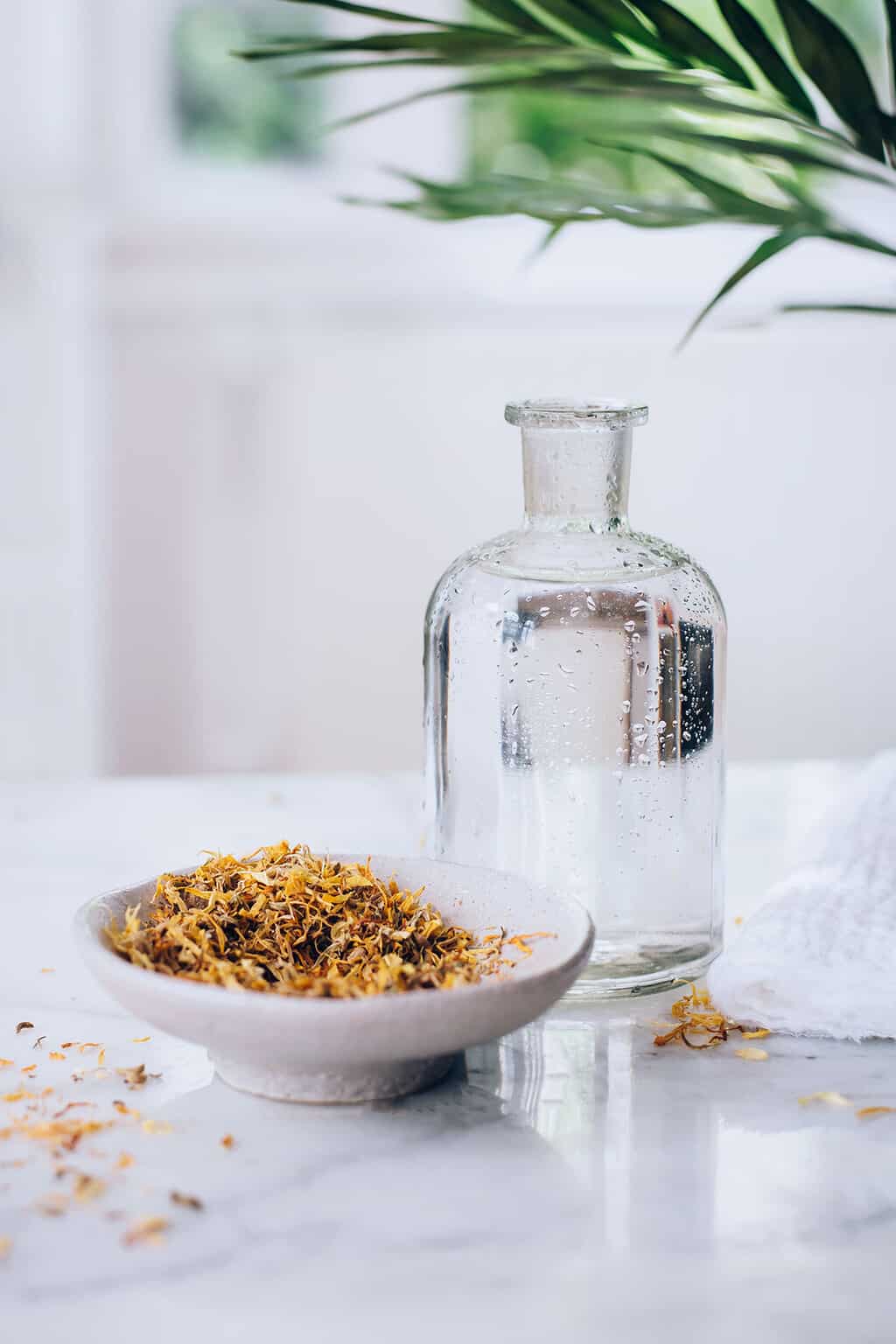
Toner prepares the skin for any additional steps in your routine, such as serums or anti-aging creams, so that they can be maximally absorbed and nourish your skin. Skip the store-bought versions, and make your own homemade toner that’s perfectly suited for your skin type:
Toners for Normal skin
1. All-purpose toner recipe
Combine ingredients in a small 4-ounce bottle and swirl to combine.
2. Firming frankincense toner
Frankincense essential oil mixed with pure water makes a simple and fragrant skin toner and refresher. New wellness benefits of frankincense essential oil are being discovered every day, and it is a known anti-inflammatory for the skin [source]. Use it after washing your face at night to wake up refreshed with firm, glowing skin.
Frankincense essential oil mixed with a hydrosol makes a simple and fragrant skin toner. Try adding it to lavender, rose, rosemary, German chamomile, or orange floral waters to refresh and further cleanse the skin.
Add water or hydrosol to a dark glass spray bottle along with the glycerin and drops of frankincense. Mix well before each use. Use it after washing your face at nighttime to wake up with radiant, glowing skin or spray onto your face and body whenever you want a refresher.
3. Vitamin C toner
Vitamin C is a vital ingredient to weave into your topical skincare routine. Try this toner for a simple and refreshing way to add ascorbic acid to your skin.
- Peel of 1 organic orange or lemon
- 1 tablespoon alcohol-free witch hazel
- Heat-safe jar + lid
- 1 cup boiling water
- Strainer
- Dark glass spray bottle
For this toner, you’ll want to be sure to use organic citrus fruit since we will be working with the peel, which is where pesticides typically settle. Take a clean lemon or orange, and remove the peel in small pieces with a knife or citrus peeler.
Add the peels to a heat-safe jar, and pour in 1 cup of boiling water. Carefully cover with the lid, making sure not to get burned, and let it steep overnight. Strain the steeped liquid into a spray bottle, and add 1 tablespoon of witch hazel. Vitamin C toner should be stored in a dark glass container to keep its potency fresh.
4. Hibiscus toner mist
A toner mist is more fun than regular toner! And hibiscus is a great source of anti-aging vitamin C, which promotes collagen formation for firm, younger-looking skin [source].
Hibiscus has amazing detoxifying properties as a tea. And it has been shown to promote skin healing and collagen formation when used topically [source]. Get the recipe for an easy hibiscus toner mist made with natural witch hazel.
Facial Toners for Oily skin
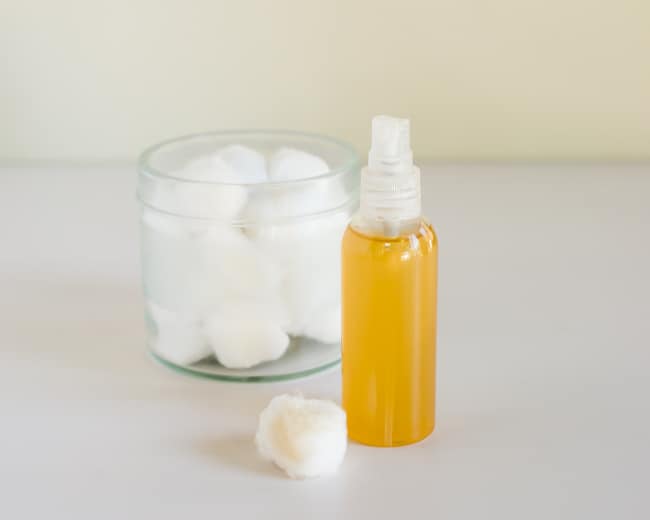
5. Astringent witch hazel toner
Witch hazel is a game-changer for cleansing pores, removing makeup, and preventing breakouts. It acts as a mild astringent to remove any dirt, oil, and makeup your cleanser might have left behind.
6. Clarifying apple cider vinegar
Naturally acidic, ACV helps prevent bacteria from clogging your pores, making it a perfect toner for oily skin. . It works on balancing the pH level of your skin.
Combine ingredients in a small 4-ounce bottle and swirl to combine.
7. Rosemary mint toner
Rosemary is a gentle—yet powerful—astringent, while mint helps reduce redness. Add a splash of naturally acidic apple cider vinegar to nix dead skin.
Boil water in a saucepan. Add the herbs, then remove from the heat and let sit until completely cool. Strain the mixture into a spray bottle, and discard the herbs. Add vinegar and swirl to combine. Shake well before each use and spritz onto clean skin. Follow with moisturizer. Keeps up to three months if refrigerated.
8. Tomato juice toner
Turn to tomato for rescuing clogged or enlarged pores. Tomato juice acts as an astringent to unclog pores, and its vitamin A helps control inflammation and excess oil [source].
- 1 teaspoon tomato juice
- 3 tablespoons distilled water
Combine these ingredients in a reclosable bottle, and shake well. Pour a few drops onto a cotton pad and sweep over skin. Keeps for 2 weeks in the fridge.
9. Yarrow toner
Make your own astringent toner with yarrow, and you’ll get an effective herbal remedy to provide a slew of antioxidants, balance excess oil production, counteract inflammation, and battle the bacteria that causes acne [source].
- 2 cups boiling water
- 2 teaspoons dried yarrow (4 teaspoons if using fresh)
Pour boiling water over the yarrow and infuse for 30 minutes. Strain and cool.
Toner Recipes for Dry skin
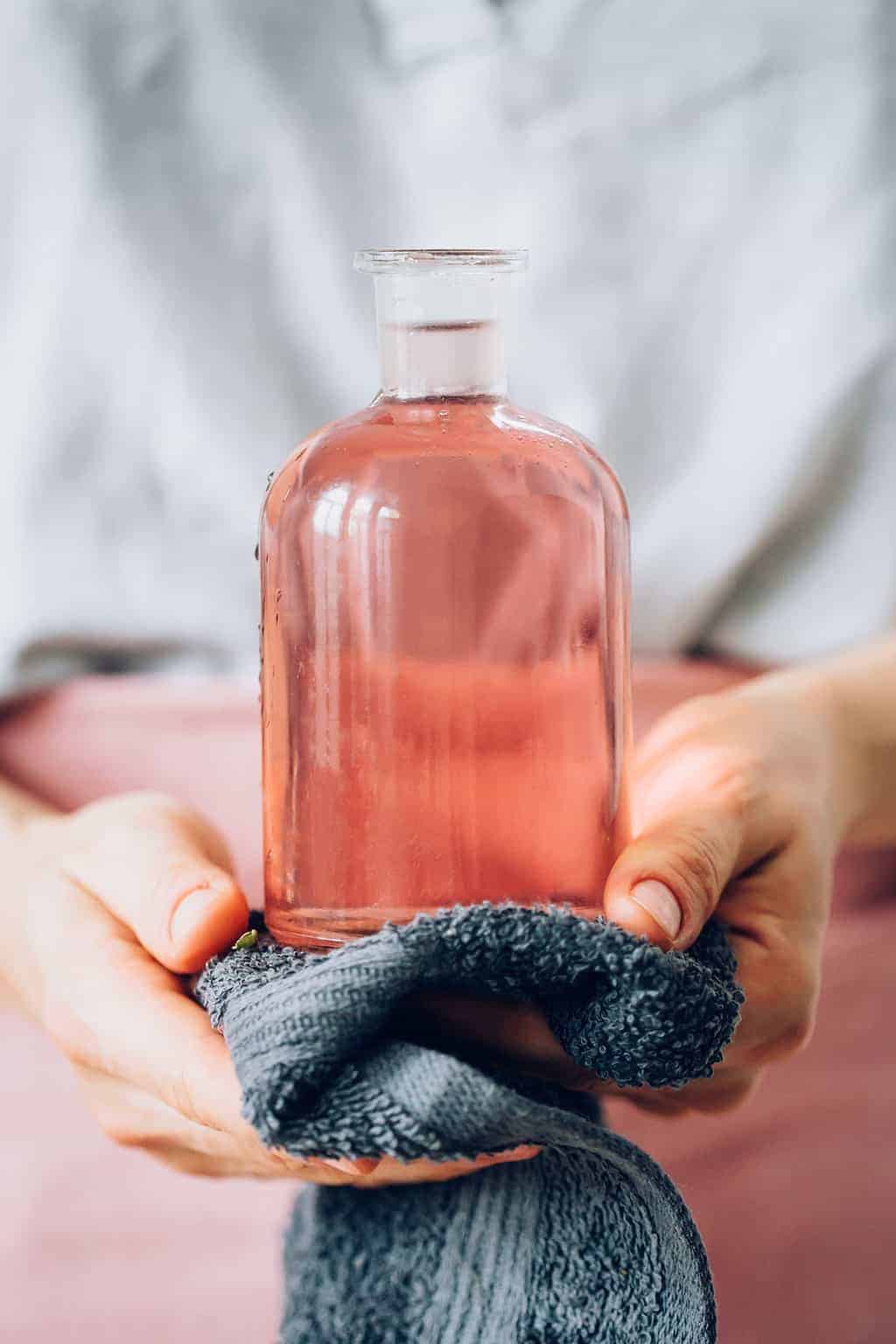
10. Neroli hyaluronic acid toner
11. Rose Water Toner
This rose water toner is fantastic for sensitive skin because it won’t dry it out. The rich antioxidant and anti-inflammatory qualities of the natural derivatives from rose petals combine to create a toner with antioxidant power that refreshes and renews the skin [source]. Glycerin is a humectant, which means it draws moisture from the air to the skin’s surface [source].
Add these ingredients into a bottle with a lid and swirl to combine. Clean your face and remove any makeup. Then apply toner with a cotton ball and follow with moisturizer.
Homemade Toner for Mature skin
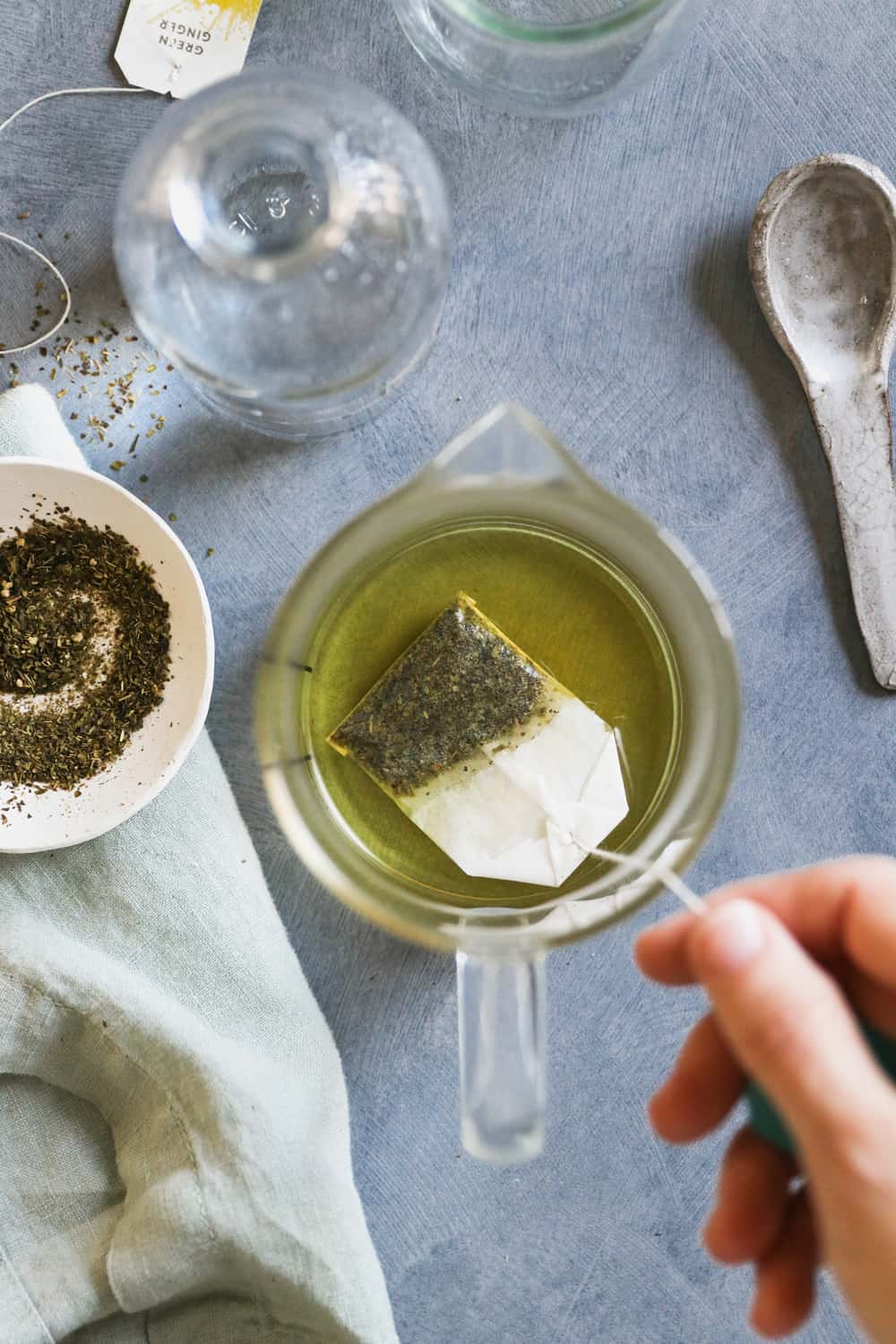
12. Green tea toner
Green tea’s safe, natural antioxidants rejuvenate the skin while reducing sun damage, eye wrinkles, and skin redness and inflammation [source]. Give your skin a dose of polyphenols that help slow down skin damage that environmental factors like sun and pollution can cause.
Put tea in a bowl and pour in the boiling water. Steep for 3 minutes, then remove the tea bags (or strain) and let the tea cool to room temperature. Put the tea in a clean bottle with a lid. Shake before each use and apply the toner with a cotton ball. Keeps up to 2 weeks in the fridge.
You can also try this anti-aging toner made with green tea and pomegranate juice. This power combo of safe, natural antioxidants rejuvenates the skin while reducing sun damage [source], eye wrinkles, and skin redness and inflammation [source].
13. White tea toner
With its high dose of antioxidants, white tea helps delay the aging process and revitalize skin for a natural glow. Just like green tea, white tea also has potent antioxidants that shield skin from the oxidative stress that causes wrinkles and hyperpigmentation.
Put 1 tea bag in a bowl and pour in 1/4 cup boiling water. Steep for 3 minutes, then remove the tea bag and let the hot tea cool to room temperature. Add the ingredients into a spritz bottle and swirl to combine. Apply to a cotton pad and sweep over clean skin. Keeps up to 2 weeks in the fridge.
14. Rice water toner
Rice is rich in minerals and vitamins that nourish skin and minimize pores. Plus, the water has a user-reported natural lightening effect on age spots and discoloration.
- 1/2 cup uncooked rice
- 1 cup water
Rinse rice and place it in a bowl with 1 cup of water. Wait 30 minutes. Strain the liquid into a reclosable bottle. Sweep the rice water over your skin with a cotton pad. Keeps 2 weeks in the refrigerator.
15. Cranberry toner
Draw in moisture and lock it in with this cranberry toner containing phytochemicals (natural plant nutrients) [source] that are especially suitable for aging skin. Use cranberry juice in combination with rosewater for an easy DIY recipe. The antioxidant properties of this toner are unsurpassed.
With its unique antibacterial compounds, pure cranberry juice makes an excellent treatment for acne flare-ups. Plus, the berries’ acidity lifts away dead skin cells and excess oil to prevent future blemishes.
- 1/4 cup rosewater
- 2 tablespoons pure cranberry juice
Combine the ingredients in a reclosable bottle. Swipe the mixture on clean skin with a cotton pad. Will keep for 2 weeks in the fridge.
DIY Toner for Sensitive skin

16. Chamomile toner to calm redness
Chamomile is a renowned skin soother! It tamps down redness and irritation, so your skin feels cooled, calmed, and refreshed. Plus, chamomile’s astringent properties tighten pores, helping to decrease oil secretion to reduce shine.
Steep the tea bag in 1 cup of boiling water for 10 minutes. Let it cool, then pour ½ cup of the tea and witch hazel into a reclosable bottle. Or you can skip the tea and use chamomile floral water instead. Shake before each use and apply to the skin with a cotton ball. Store it in the fridge for up to a month.
17. Cucumber toner
- Juice from 1/2 a cucumber
- 3 tablespoons distilled water
- 2 tablespoons aloe vera juice
Puree the cucumber with the water, then pour through a fine mesh strainer into a clean spray bottle. Add aloe juice. Chill and spritz directly on your face (keep your eyes closed) or onto a cotton pad and sweep over skin. Will keep for 2 weeks in the fridge.
18. Parsley Water
Parsley water is particularly good for cleansing blackheads.
- 1 cup water
- 1/2 cup parsley, preferably organic
Boil water and pour over the parsley. Cool completely, then strain. Will keep for 2 weeks in the fridge.
19. Fennel Toner
Fennel is known to rejuvenate the skin and reduce inflammation, and it has also been shown to have anti-aging effects, so it’s the perfect ingredient for your homemade toner [source]! Get the recipe here—you only need some thyme, lemon, and water to get started!
This post was medically reviewed by Dr. Jennifer Haley, a board-certified dermatologist with extensive experience in medical, cosmetic, and surgical dermatology. Learn more about Hello Glow’s medical reviewers here. As always, this is not personal medical advice, and we recommend that you talk with your doctor.
Source by helloglow.co
